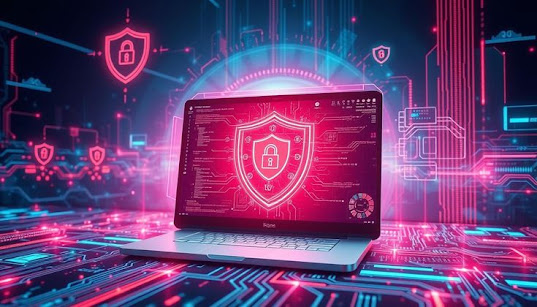AI vs Hackers: Who’s Winning the Cybersecurity War in 2025
AI vs. Hackers: Who’s Winning the Cybersecurity War in 2025?
Artificial Intelligence (AI) and cybercrime are in a constant arms race in 2025. As organizations deploy intelligent systems to protect data, hackers are turning to AI to break through those very defenses. But which side has the upper hand?
This blog dives deep into the evolving dynamics of cybersecurity, exploring how AI is used by both cyber defenders and cybercriminals. It’s no longer about firewalls and antivirus — it’s about smart algorithms, predictive models, and machine-generated attacks.
A. The Evolution of Cybersecurity: From Manual to Machine Learning
Traditionally, cybersecurity relied on human monitoring, rule-based systems, and manual threat detection. But as attacks became more complex and frequent, the shift toward automation began.
By 2025, over 80% of threat detection and response systems include AI components, from endpoint protection to network monitoring and fraud analysis.
Key Milestones in AI Cybersecurity
- 2020–2022: Introduction of ML in antivirus systems
- 2023: AI-based phishing detection tools become mainstream
- 2024: Behavioral biometrics powered by AI adopted for login security
- 2025: Real-time predictive threat modeling becomes critical
B. How AI Is Revolutionizing Cyber Defense
AI allows organizations to detect and respond to threats at machine speed, reducing human response times and minimizing data loss.
1. Threat Detection and Anomaly Recognition
Machine learning models analyze billions of data points to find patterns no human could notice. This includes unusual login behaviors, unexpected traffic spikes, or behavioral changes on endpoints.
2. Automated Incident Response
AI-powered SOAR (Security Orchestration, Automation, and Response) tools take immediate action — isolating devices, blocking IPs, or initiating recovery protocols — without waiting for human input.
3. Predictive Threat Intelligence
AI systems analyze historical data, hacker forums, and dark web chatter to predict future attacks and identify emerging malware before it spreads.
C. The Dark Side: Hackers Using AI as a Weapon
Hackers have also embraced AI — and not just for evasion. They're building malware that adapts in real-time, phishing messages that mimic your writing style, and bots that exploit software faster than you can patch it.
1. AI-Powered Malware
Unlike traditional malware, these self-evolving threats learn from network behavior and change signatures to avoid detection. Some even disable security tools autonomously.
2. Deepfake Social Engineering
Cybercriminals use deepfake audio and video to impersonate CEOs or colleagues, tricking employees into wire transfers or leaking credentials.
3. AI-Enhanced Phishing
AI-generated phishing emails are context-aware, personalized, and more convincing than ever. Attackers scrape social media and use NLP to sound authentic.
D. Notable AI-Driven Attacks in 2025
This year alone, several major incidents revealed how dangerous AI-augmented cybercrime has become.
- FinTech Breach (February 2025): A generative AI bot infiltrated a payment processor, bypassing CAPTCHAs and mimicking employee emails to exfiltrate data.
- Deepfake CEO Scam (March 2025): A European firm's CFO was duped by a synthetic voice call from a "CEO," leading to a $1.2 million wire transfer.
- Smart Home Botnet (April 2025): AI-linked malware spread through IoT devices, launching coordinated DDoS attacks from millions of thermostats and cameras.
E. Government and Industry Response
As threats intensify, governments and private companies are heavily investing in AI-based cyber defenses.
1. Regulatory Moves
The EU and US have passed new regulations in 2025 requiring AI transparency in cybersecurity platforms and stronger compliance in automated decision-making systems.
2. Cybersecurity-as-a-Service (CSaaS)
Small and medium businesses can now subscribe to AI-driven cybersecurity platforms that offer real-time monitoring, alerting, and remediation.
3. Cyber AI Task Forces
Agencies like the FBI and INTERPOL now deploy AI in active threat hunting, counterintelligence, and tracking state-sponsored attacks.
F. Future Trends: The Road Ahead
The war between AI defenders and AI attackers is just beginning. Here's what the future might hold:
- Neuro-AI Security: Systems that understand and protect based on human intent and behavior patterns
- Self-healing networks: Automatically detect and patch vulnerabilities before attackers can exploit them
- Ethical AI Development: Mandated use of explainable, accountable AI models in cybersecurity
G. Who’s Winning the Cybersecurity War in 2025?
The winner in 2025 isn’t just who has the best AI — it’s who can deploy it faster, more intelligently, and more ethically.
Right now, AI defenders have a technical edge, but the gap is closing. Attackers are agile, decentralized, and increasingly funded. As generative AI becomes more powerful and accessible, it may tip the scale either way.
H. What Can Individuals and Organizations Do?
Even with the best tools, humans remain a critical part of cybersecurity. Awareness, training, and smart habits are still the strongest first line of defense.
Tips for Businesses
- Invest in AI-driven security tools with threat intelligence capabilities
- Use multi-factor and biometric authentication systems
- Continuously update and audit software, firmware, and IoT devices
- Train employees to recognize phishing and social engineering
Tips for Individuals
- Never trust unknown calls, even if they sound real
- Use password managers and strong unique passwords
- Keep devices and antivirus updated
- Enable biometric or passkey-based logins where possible
I. Conclusion: Stay Ahead of the Curve
The AI vs. Hackers battle in 2025 is a test of intelligence, adaptation, and resilience. While the lines blur and the tools evolve, one thing remains constant — the need for proactive, intelligent, and ethical cybersecurity practices.
Whether you're a business leader, IT professional, or just a smart device user, staying informed and adopting AI-enhanced protection can make the difference between safety and breach.
Stay vigilant. Stay adaptive. Stay secure.







Comments
Post a Comment